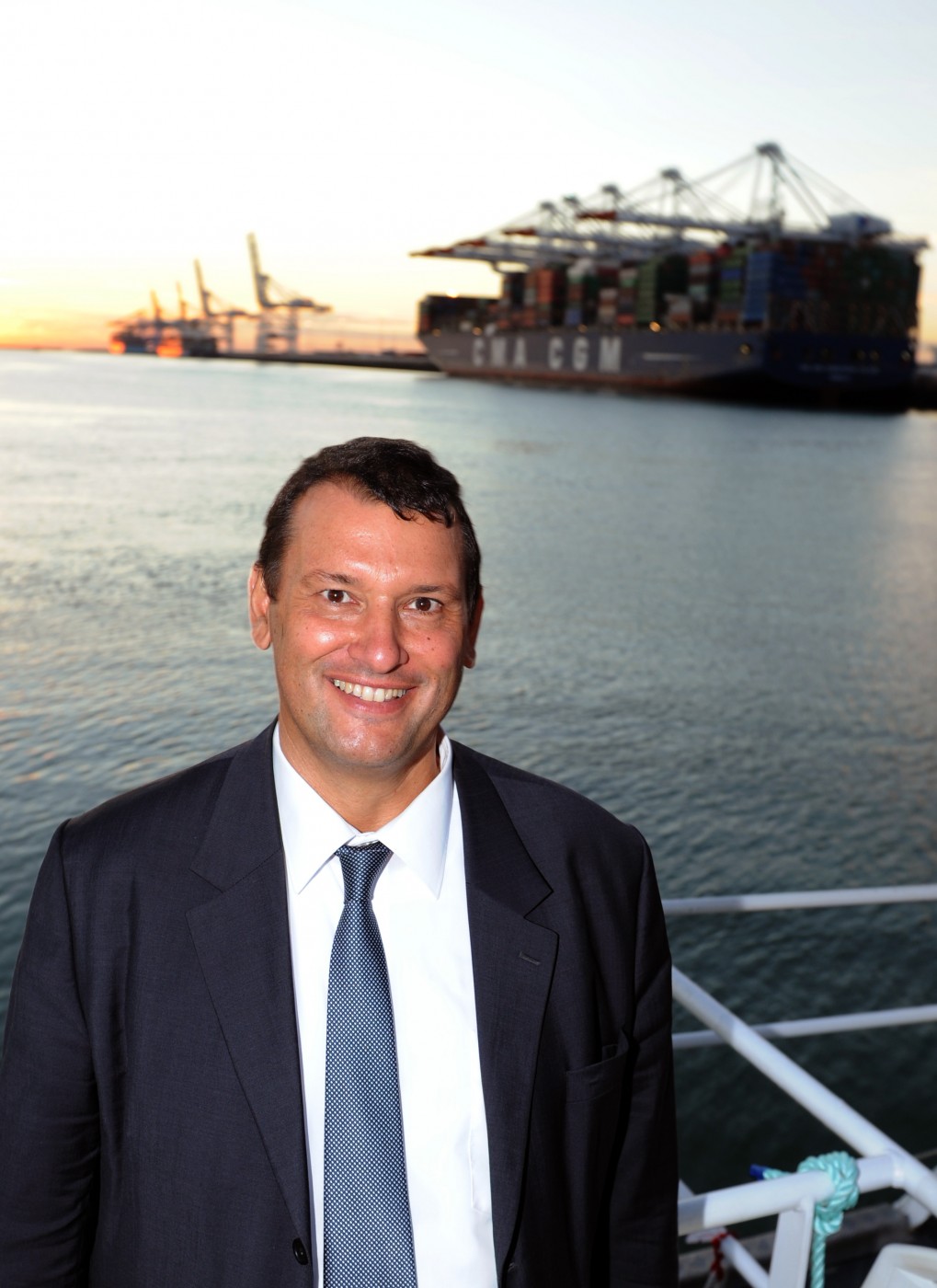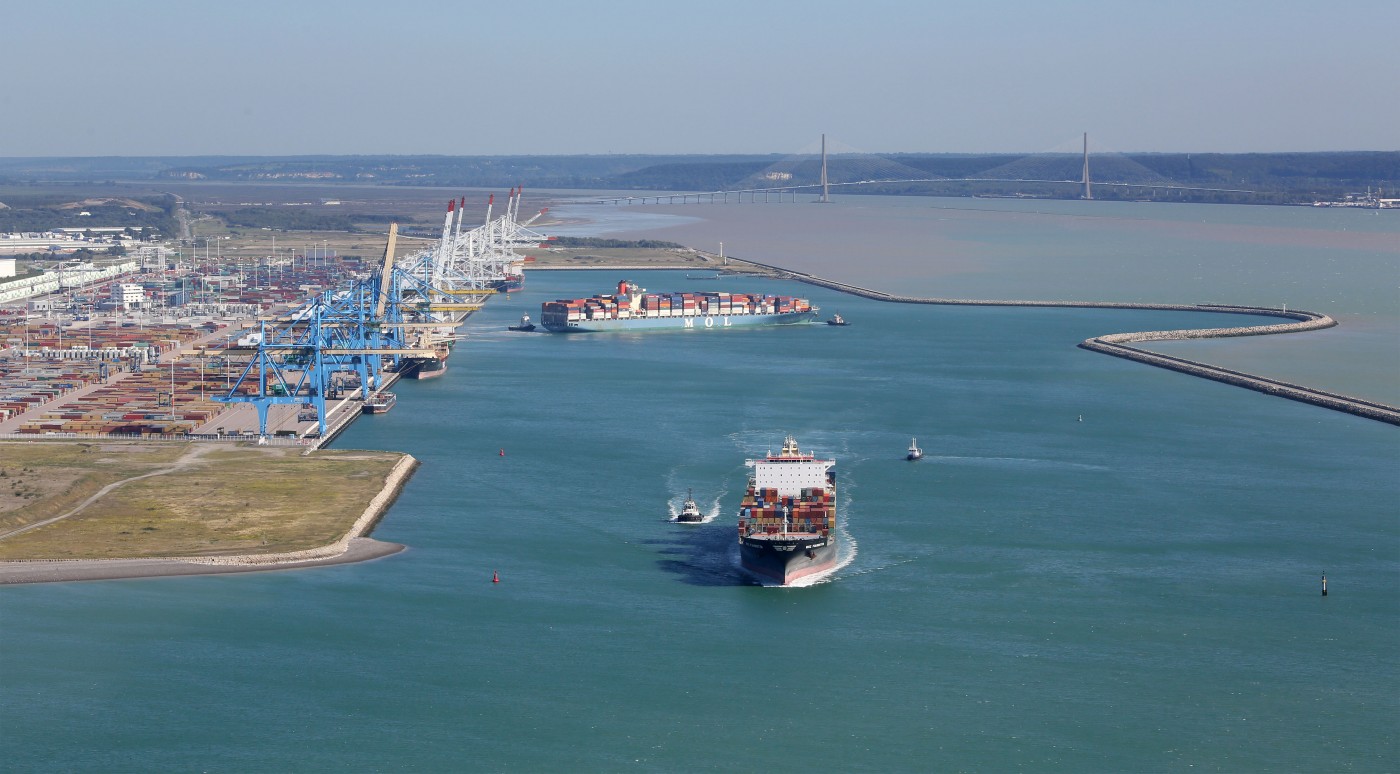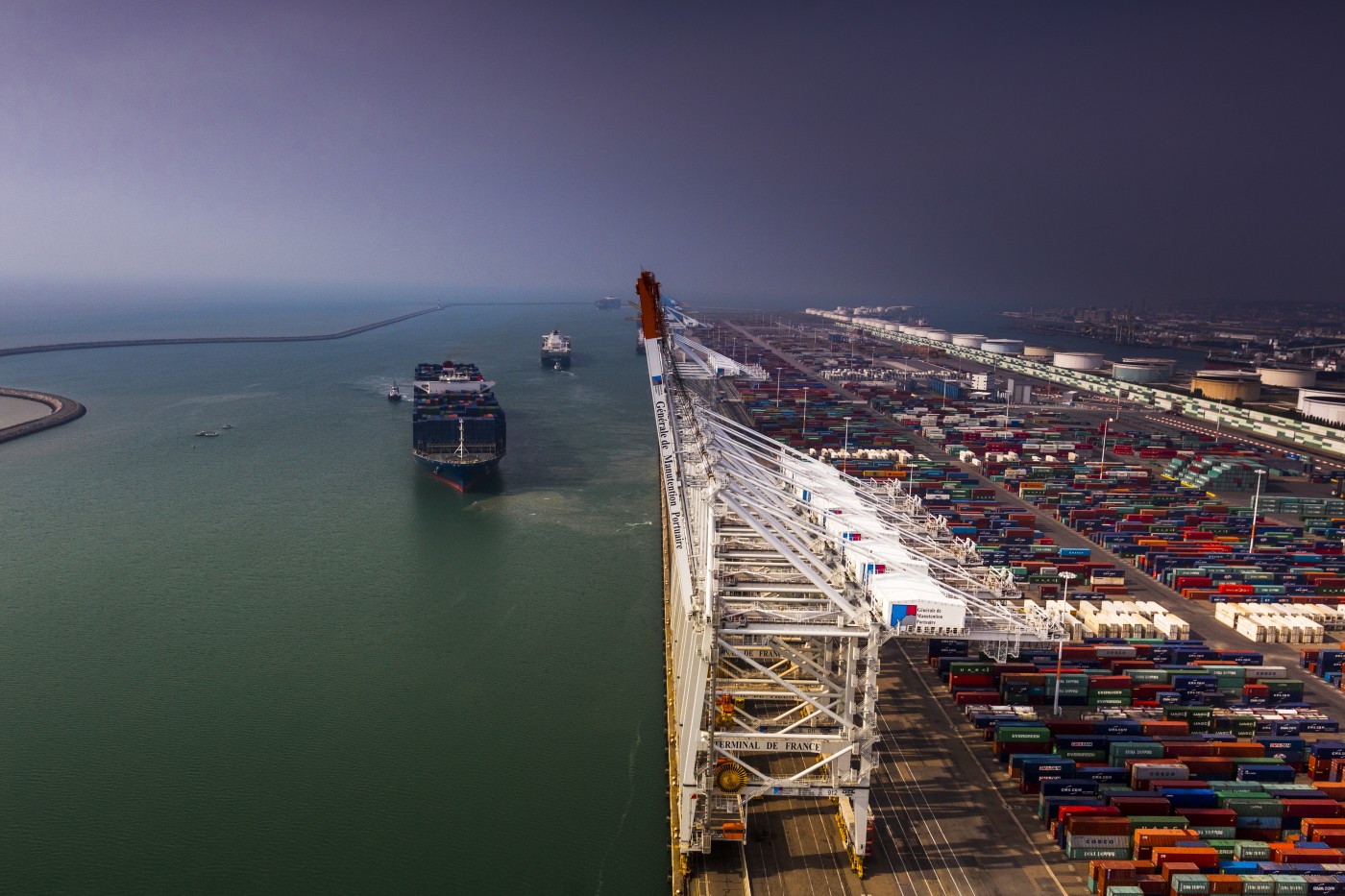31 January 2018
In this Port pro of the month, we are interviewing Mr Hervé Martel, Executive Director of HAROPA Port du Havre (France). We asked him about his views on the current state of play in his port, his vision for the future and his opinion on some challenges which ports are facing today.

Since 2009, ESPO shares an office with EFIP, the European Federation of Inland Ports, thereby creating more synergies between sea ports and inland ports. In 2012, the Ports of Le Havre, Rouen and Paris united themselves in HAROPA, setting up a unique joint venture between inland and sea ports. Can you briefly tell us why you decided to set up a joint venture? What are the advantages and what are the challenges?
The joint venture “HAROPA” reflects the ambition of the three ports of the Seine Valley to form a major port system relying on the forces of each of the three ports of Le Havre, Rouen and Paris, which are located in the heart of one of the wealthiest production and consumer areas in Europe that has more than 22 million inhabitants. As major economic stakeholder of the Seine valley, HAROPA ports is responsible for more than 64 000 employees and generates about 7 billion euros per year. HAROPA was created to derive advantages of higher visibility by being identified as a European-sized competitive and innovative system. We wanted to propose more pertinent logistics solutions to the clients of HAROPA and cope with the competition of Northern European ports. The challenge was ensuring sustainable characteristics for the logistics chains, thus allowing competitive, safe, reliable and green transport of goods for our regions. This meant working on port level to facilitate cargo transit from vessels to river barges, trains and trucks and increasing multimodality along the whole Seine corridor and valley. Other challenges included the creation of a sustainable industrial cluster offering optimal solutions for business start-up and operation along the Seine corridor, the contribution to make the river Seine an attractive tourist area and the desire to become a benchmark in terms of integration of the port in its urban and natural environment. We thus had to reconcile preservation of the bio-diversity and economic growth and give guarantees in terms of limitation of nuisances, pollutions and industrial hazards. The advantage of the alliance lies in the synergy generated which enabled HAROPA ports to settle their position on the North-European range and increase the pertinence of their business offers with the partnerships concluded with other ports in the Seine Valley, in Normandy and even with other world ports to assist customers and favour new business agreements.
What is your vision for the Port of Le Havre for the next decade?
HAROPA - Port of Le Havre has defined development strategies for the next years, with a real policy of development of the activities generating sea traffic such as container trade and logistics. The port aims at increasing the number of containers handled via Le Havre by even further improving the quality of the service offered to shipping lines and achieving port transit excellence, by structuring the logistics offer and strengthening the multimodal solutions. It aims at achieving a certain number of projects such as the rising strength of the multimodal terminal for consolidation and the improvement of the river access to Port 2000 container terminals, the modernisation of the rail links for freight, the assistance to the development of maritime combined transport services and the identification of innovative solutions to serve the Paris area and the extended hinterland. Another aspect of port development is the continuation of the implementation of local sustainable development, by relying upon the Development Scheme of the port and nature (SDPN in French) which determines the sites to transform and urbanise in priority. It is also a matter of building a new economic model for the port to be able to get enough self-financing to start investing in its vital development plans.
Oil traffic plays an important role in the Port of Le Havre. Fossil fuels such as oil are more and more discouraged due to decarbonisation policies. In view of this, are you developing a strategy in order to respond to these developments, for instance by diversifying more the activities in your port?
Of course, we are working hard to diversify our activities. Our objective is developing our port land as real estate resources. It only represents a third of our business now and we could use the land entrusted to us more. We also have to make productivity efforts while managing our expenses, optimising our resources, avoiding over-investments, that is to say we have to strengthen our economic model, facilitate and simplify business start-up on our port land and extend our hinterland via consolidated rail and river infrastructure to catch traffic further.
The Port of Le Havre has a ferry service to the United Kingdom. Will the Brexit have an impact on the Port of Le Havre? How are you preparing yourself for the consequences of Brexit?
It is particularly difficult to fully apprehend the consequences of Brexit on the activity of the Port of Le Havre as the measures are not yet approved and in force. A first analysis shows that traffic with the UK, except Ro-Ro, represents a low part of our overall business. Ro-Ro traffic is that with the highest potential impact as it accounts for more than half the total trade with the UK. However, as the part of the total HAROPA traffic made with the UK represents less than 1.5 % of our total tonnage, the impact does not seem to be significant.
(c) Vincent Rustuel
Having efficient customs in the port is important to ensure the smooth cargo movements. Is the Port of Le Havre taking any initiatives with the customs to avoid bottlenecks and cut red tape?
The Customs offer is accessible via a computerised port single window for all HAROPA ports. This is a computer system (a cargo community system) to which the computer systems of ship reception in Le Havre and Rouen and that of Customs are connected. Port authorities and the different stakeholders organising the transport chains are interconnected and exchange their data. This system especially allows to facilitate customs clearance operations. Today, 98% of cargo is cleared through customs without physical inspection. This system continues to improve. The SOGET Company, which is developing it, is testing a new-generation software along the Seine corridor named S)One. Customs have implemented a certain number of services with HAROPA – Port of Le Havre to assist the development of trades (e.g. Ro-Ro with working groups and tailor-made measures). They are present with HAROPA at trade exhibitions and international business events in France and abroad. They are included in all our communication publications (booklets, brochures, press releases, etc.). They have created a social unit to give assistance to companies, personalised advice and facilitate tailor-made solutions for customers.
We know that the Port of Le Havre covers an area bigger than the city of Paris, with both populated and natural areas surrounding the port. The integration of the port in the city and finding the right balance of port activity with nature are thus of paramount importance. How does the Port of Le Havre ensure the sustainability of port activity towards the population and nature surrounding the port?
HAROPA invests in its relations with cities. Ports are not extraterritorial zones: ports are part of cities, serving the cities and consequently, they have to show it. We are convinced that industrial facilities and urban spaces can cohabit in harmony within the framework of mixed uses. This can be achieved by the development of the city-port interface, which must preserve urban and architectural continuity. Among the most striking examples, we can mention in Le Havre the ongoing redevelopment of the Southampton wharf aiming to refit it in the heart of the city by integrating walks and reception areas. In addition, Le Havre's "Port Center" is a point of geographical and cultural encounters between the port and the city. This year, the Port of Le Havre will celebrate the 500th anniversary of Le Havre. In this context, HAROPA initiated the "Reinventing the Seine" project, which is a call for innovative projects to reinvent new ways of living on and at the water's edge on the Paris - Rouen - Le Havre axis. This corridor represents more than 15 million inhabitants. It structures a dense mesh of cities and constitutes the opening on the sea of the "city-world" which is the Paris metropolis. The Seine Valley offers exceptional tourist sites with strong international influence (The crossing of Paris, Le Havre UNESCO World Heritage, Normandy Impressionist,...)."Reinventing the Seine" has to be the proof that we can reconcile economic development and quality of life of the inhabitants. Out of about forty sites in total, 17 port sites are owned by the ports of Le Havre, Rouen and Paris. These are sites intended for logistics or leisure establishments, the key word here being innovation.
In 2015, the Port of Le Havre received for the first time the Port Environmental Review System (PERS) certification, which is the only port sector specific environmental management standard. The Paris Agreement, which was concluded last year, is urging the world to do more in order to prevent climate change. Is HAROPA taking any steps in reducing CO2 emissions? How do you think ports can contribute to further reducing emissions?
The Green Port line is a priority of HAROPA, it strives to make the port ever more environmentally friendly. The initiatives are numerous and are generally collaborative by involving authorities and port stakeholders. They include the use of new fuels and electricity as a substitute for petroleum products. HAROPA is involved in European projects aiming to use LNG, for example: the "SamueLNG" project: to equip the dredge ‘Samuel de Champlin’ (which operates 40% of its time on the ports of Le Havre and Rouen) with LNG. The SAFE SECA project is preparing fuelling solutions, particularly for LNG, at the HAROPA and Baie de Seine levels. Since May 2016, the cruise vessel AidaPRIMA weekly uses LNG at Le Havre, to produce its electric power at berth. These steps aim to meet the European directive on the deployment of alternative fuel infrastructure, requiring Member States to ensure that a number of LNG refuelling points are available at ports. The use of GTL (gas-to-liquid) fuel is being tested. The first results concerning the current trial are encouraging and make it possible to consider GTL fuel as an interesting tool in the context of the energy transition. As part of the innovative call “Re-inventing the Seine”, navigation units using electric engines will be built, for example the "Moulin Seine" project, which reinvents the Seine as a way of transport in the city. The Moulin serves as a home port for a fleet of 3 small 12-seater electric propulsion boats specially created for the call for projects. The boats provide the logistics of the mill: the supply of raw materials and the distribution of bakery products. They transform into small comfortable lounges for picnic cruises and limousine boats serving stopovers on the Seine. Other river owners are also thinking about electric propulsion units like for example Paris Yacht Marina. Recently, HAROPA - Ports of Paris has set up a prize list that rewards virtuous boats. For these numerous initiatives, HAROPA has already been rewarded several times. Indeed, the ports of the Seine corridor have received the Best Green Port award for 3 consecutive years in 2015, 2016 and 2017.

ESPO is a partner of PORTOPIA, an FP7 project that aims to measure port performance. How are you measuring your port’s performance?
We set up performance indicators for the first time in 2014, initiated by the port of Le Havre. The approach is intended to be carried out also for the ports of Rouen and Paris. The objective is to measure the maritime / land / goods / customs and sanitary performance on HAROPA. This initiative, carried out in close collaboration with all the professionals of the port of Le Havre, represents each year a collaborative work in the service of and with the customers. This dynamic move towards progress makes it possible to measure objectively the attractiveness of the port and to position its performance throughout the supply chain.
For the 3rd year in a row, HAROPA has published performance indicators. In 2016, for the first time, the document integrated Rouen's maritime performance. That’s how you can learn that the Havre port call satisfaction rate reached 99.7 % in 2016, the number of ports connected to the Port of Le Havre with liner shipping services increased to 667 ports and 74 % of port customers are certified as Authorised Economic Operators (AEO). It’s also worth noting, for instance, the improvement of the lead-time required to obtain the "gate-out" authorisation as part of the performance of the goods transit, the excellent ranking in "Doing business" of the French Customs by the World Bank; and always, the possibility for freight forwarders, logisticians, carriers, etc., to get closer to SOGET to evaluate their own performance and position themselves in relation to the competition and the needs of customers.
You are now president of the Port of Le Havre and we assume you love your job. However, was this the job you had in mind in your 20s? How did your career path led to this job?
Of course, I love the job as I am particularly keen on shipping, maritime affairs and ports. The first time I got in contact with ports was in 1989, during a Volunteer Mission to the Réunion Island. I had just left the National School of Public Works, I had decided to choose the option transport economy, and, in parallel, I had taken a class of DEA in transport economics at LET (Laboratory of Transport Economics). I wanted to do my national service (as VTA, Volunteer for Technical Assistance) and learned that a volunteer at La Réunion was required. If this opportunity seemed to be unexpected at that time, the context of a port (passengers, freight) pleased me at once: the destination was comfortable, I loved the sea, sailing and diving, and transport matters were present.
The virus caught me during this internship and I felt very interested in the subject. I discovered a diversity of professions that go beyond the mere construction of infrastructures and their operation and management, a universe of actors and economic exchanges and specialised professions. It was a new world, a different field, whose taste was not really acquired at school, but rested on deep and concrete roots. My interest then confirmed and amplified. In 1992, I held a job in central administration which made me take a step back but I did not feel motivated in it because it was a bit distant from economic matters. I really tried to return to a port and I really enjoyed going to the BCEOM (now Egis) where I stayed for five years as a consultant, immersing myself in master plans, strategic projects, privatisations and institutional reorganisations. At this point, I fully expressed myself, and from there my interest for port and shipping matters was really strengthened.
Related documents
No attachments.

